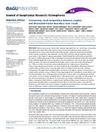The Marine Stratus/Stratocumulus Experiment (MASE): Aerosol-cloud relationships in marine stratocumulus
| dc.contributor.author | Lu, Miao-Lu | |
| dc.contributor.author | Conant, WIlliam C. | |
| dc.contributor.author | Jonsson, Haflidi H. | |
| dc.contributor.author | Varutbangkul, Varuntida | |
| dc.contributor.author | Flagan, Richard C. | |
| dc.contributor.author | Seinfeld, John H. | |
| dc.date | 2007 | |
| dc.date.accessioned | 2014-06-11T23:18:39Z | |
| dc.date.available | 2014-06-11T23:18:39Z | |
| dc.date.issued | 2007 | |
| dc.identifier.uri | https://hdl.handle.net/10945/42271 | |
| dc.description | Journal of Geophysical Research, Vol. 112, D10209 | en_US |
| dc.description | The article of record as published may be located at http://dx.doi.org/10.1029/2006JD007985. | en_US |
| dc.description.abstract | The Marine Stratus/Stratocumulus Experiment (MASE) field campaign was undertaken in July 2005 off the coast of Monterey, California to evaluate aerosol-cloud relationships in the climatically important regime of eastern Pacific marine stratocumulus. Aerosol and cloud properties were measured onboard the Center for Interdisciplinary Remotely-Piloted Aircraft Studies (CIRPAS) Twin Otter aircraft. One cloud that was clearly impacted by ship emissions as well as the ensemble of clouds observed over the entire mission are analyzed in detail. Results at both the individual and ensemble scales clearly confirm the Twomey effect (first indirect effect of aerosols) and demonstrate drizzle suppression at elevated aerosol number concentration. For the ship track impacted cloud, suppressed drizzle in the track led to a larger cloud liquid water path (LWP) at the same cloud thickness, in accord with the so-called second indirect effect. Ensemble averages over all clouds sampled over the entire 13-flight mission show the opposite effect of aerosol number concentration on LWP, presumably the result of other dynamic influences (e.g., updraft velocity and ambient sounding profile). Individual polluted clouds were found to exhibit a narrower cloud drop spectral width in accord with theoretical prediction (M.-L. Lu and J. H. Seinfeld, Effect of aerosol number concentration on cloud droplet dispersion: A large-eddy simulation study and implications for aerosol indirect forcing, Journal of Geophysical Research, 2006). This field experiment demonstrates both the indirect aerosol effect on ship track perturbed clouds, as well as the subtleties involved in extracting these effects over an ensemble of clouds sampled over a 1-month period. | en_US |
| dc.rights | This publication is a work of the U.S. Government as defined in Title 17, United States Code, Section 101. Copyright protection is not available for this work in the United States. | en_US |
| dc.title | The Marine Stratus/Stratocumulus Experiment (MASE): Aerosol-cloud relationships in marine stratocumulus | en_US |
| dc.contributor.department | Center for Interdisciplinary Remotely Piloted Aircraft Studies (CIRPAS) |





